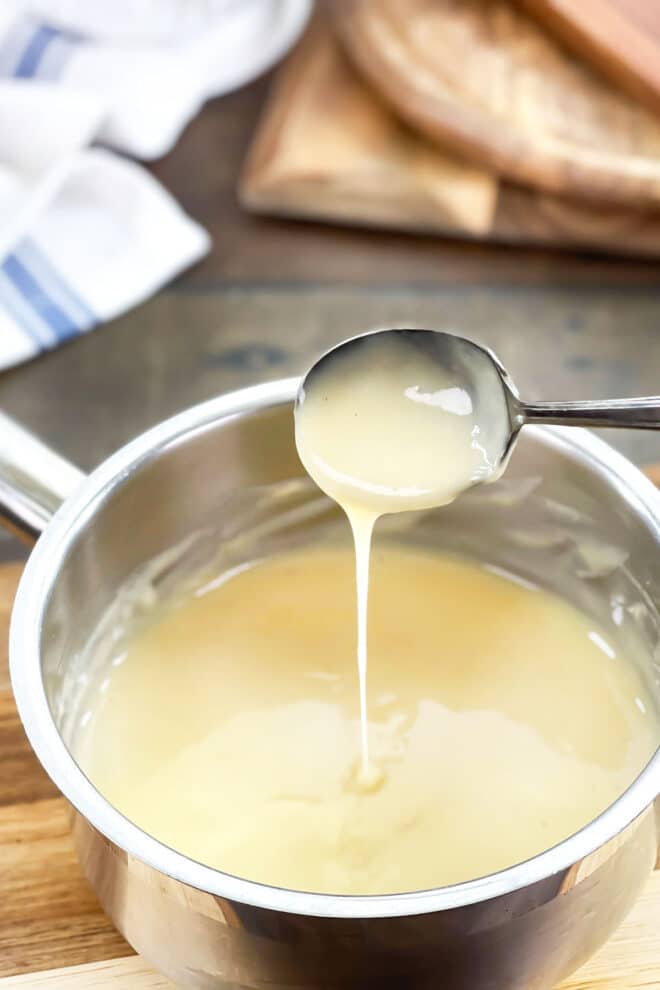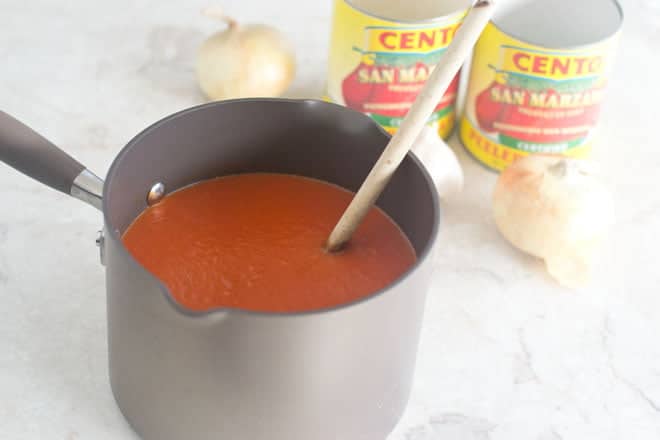Learn how to make a classic velouté sauce! It’s an easy but impressive sauce that can be adapted in many different ways.
Velouté sauce sounds super fancy, but it’s actually a fairly basic sauce to make and one that can be used as the starting point for so many other sauces and dishes. This ‘mother sauce’ is a great recipe to know how to make and it only has a few required ingredients to make this classic velvety sauce – butter, flour, and stock.
Read more about this sauce and its variations below or click here to head straight to the recipe.

What Is Velouté Sauce?
Velouté is one of the “mother sauces” of classic French cuisine. The word velouté (pronounced “vuh-loo-TAY”) means velvety and this sauce only requires a few ingredients to make it so – butter, flour, and some type of stock or broth. The most common is made with chicken stock, but fish or veal stock can be used as well.
While this velvety sauce is delicious on its own, it’s also a great base to which you can add other flavors and seasonings such as herbs, shallots, wine, lemon juice, and more to create other, more complex sauces.
Are Velouté and Béchamel The Same Thing?
No, béchamel is made with milk whereas velouté is made with a pale-colored stock or broth. But the general idea is similar and you can use velouté in many of the same places as béchamel. The other main difference is that béchamel uses a white roux whereas velouté uses a blond roux. A white roux is when you combine the butter and flour just until it forms a paste, but you don’t cook it at all after that. A blond roux is one that is cooked until it has an ivory color and nutty aroma.
A nice thing about velouté as compared to béchamel is that it won’t curdle. Since béchamel is made with milk and you’re heating it, it’s always possible that it can separate. Also, if you add acidic ingredients, that can also cause the milk to separate and thus curdle. With velouté sauce, however, there is no milk involved and so there is nothing there that can curdle. Adding acidic ingredients and heating the sauce is therefore easier. Due to the milk (or sometimes cream) though, béchamel has a richer flavor. Choosing which of the two sauce you want to use will therefore depend on what you want to serve it with. Here is my delicious classic béchamel recipe, in case you decide to go that route.
What Is Velouté Sauce Used For?
One main thing is that it’s used for is to make velouté soups. Velouté soups are a kind of creamy soup, but they crucially include a roux. You can essentially make a velouté sauce, and then add a vegetable puree and season. Some velouté soups are also richened with egg, as explained below in the variations section.
Velouté Sauce Ratios
As with a béchamel, you’ll use equal amounts of butter and flour when making your roux. The amount of butter and flour you use per cup of liquid then depends on how thick you’d like your sauce to be.
For a basic sauce, use 1 tablespoon each of butter and flour to 1 cup of stock/broth. This will be great for pouring over fish, poultry, meat, or vegetables.
For the base of a soup, or if you just want a thicker sauce, then use 1 and 1/2 to 2 tablespoons each of butter and flour per 1 cup of stock/broth.
Too Thick Or Too Thin Sauce?
Note that it’s actually easier to thin a sauce that is too thick than it is to thicken a sauce that is too thin. So erring on the side of thicker is often a good choice, which is what I have done in the recipe below.
To thin out a sauce that is too thick, you’ll simply whisk in more stock.
To thicken a sauce that is too thin, you can warm it over medium-low heat until it reduces. Alternatively, mix together equal parts softened butter and flour (this mixture is called a beurre manié). Take your sauce off of the heat and let it cool for a few minutes. Then whisk in dollops of the beurre manié. Put the sauce back over medium-low heat until it thickens.
Easier Velouté Sauce
Despite its fancy sounding name, you can make this sauce in about 20 minutes and with only three required ingredients. At that point, you can use it as is or add to it to make other sauce variations.
The classic way to make a velouté sauce is to heat the stock separately, then slowly add it to your roux. However, I actually find this a tad more difficult for people who are new to making sauces since the hot stock can very quickly cook the flour and form lumps. In the recipe below, I therefore don’t heat the broth first, but add it room temperature to the roux. This also means that I’m only dirtying one saucepan, so that’s a little bonus! If you’re experienced at sauce-making, go ahead and heat your stock first.
How To Make Velouté Sauce
To make this velouté sauce recipe, start by making a blond roux. A roux is made with equal parts butter and flour, a blond roux is simply one that does not cook long enough to darken like you would for a gumbo base or for a dark sauce like Sauce Espagnole.
Cook your roux over low heat for 5-7 minutes, until it’s an ivory color, then start to add the stock. I usually use chicken stock for my velouté recipe, but it can also be made with fish, veal, or vegetable stock depending on how you plan to use it. Add a quarter cup of the stock first and use a whisk to mix in the roux, because you don’t want lumps of flour.
Slowly pour in the remaining stock while continuing to whisk and then bring to a simmer over medium heat, stirring often. Turn heat back to low, and cook for another 10-15 minutes, until it can nearly coat the back of a spoon. Keep an eye on it and keep stirring though, you don’t want the sauce to burn on the bottom of the pot.
Once it’s the correct thickness, you can season with salt to taste and add some white pepper and nutmeg if desired. The nutmeg gives an extra nutty note, which enhances the nuttiness of the blond roux the sauce is based around.
Do you have to use white pepper? No. As with bechamel, white pepper is typically used so that you don’t see the little dark spots in there. However, if you don’t care about the dark spots, go in with regular black pepper. Or, you can just skip the pepper.
Velouté Sauce Variations
Now that you know the basics of this mother sauce, you can create so many sauces that are variations of velouté.
A little bit of lemon juice can be stirred in right before serving to lighten it up and give it a little tang. This is great for fish and seafood dishes, especially.
Some heavy cream can also be added to give it more richness. It is then called sauce suprême. This is wonderful served on vegetables and on chicken.
The recipe calls for chicken stock, but you can use whatever kind of pale stock will work for the meal you’re making. Vegetable stock can be used for veggies or to make the sauce vegetarian. Fish stock or clam juice can be used if this is being served with or on fish. You can still add the lemon juice then too!
Just before serving the sauce, you can add 1 to 2 tablespoons of butter, and whisk it in. This adds a lot of richness. Flavored butters are also wonderful here, like my garlic butter, truffle butter, or herbed butter (wonderful on turkey!).
Sauce Allemande is actually a basic velouté that is richened with egg. You’ll make the basic sauce below, and then you’ll add a bit of extra stock to it (3/4 cup). Let that warm and reduce a bit. Then whisk an egg yolk with 2 tablespoons of heavy cream, and stir that into the soup. Cook over low heat, not simmering, until slightly thickened. You’ll want to add in some lemon juice and a bit of butter after that. If any egg has solidified, go ahead and stain the sauce through a fine mesh sieve.
More Delicious Sauce Recipes
I love a good sauce. If you’re with me on this, you have to check out my whole collection of delicious sauce recipes. I’m also linking to some of my most favorite ones here for you:
- Bacon Gravy
- Spaghetti Sauce
- Homemade Horseradish Sauce
- Classic Hollandaise Sauce
- Garlic Butter Sauce
Podcast Episode: Making Velouté Sauce
Listen to learn how to make this recipe, along with some great tips from me along the way:
Listen to more Recipe of the Day episodes here.
Print
Velouté Sauce Recipe
- Prep Time: 0 minutes
- Cook Time: 20 minutes
- Total Time: 20 minutes
- Yield: 1 and 1/2 cups 1x
- Category: Sauce
- Method: Stovetop
- Cuisine: French
Ingredients
- 3 Tbsp. unsalted butter
- 3 Tbsp. all-purpose flour
- 2 cups pale-colored stock or broth, divided
- Salt
- White Pepper (optional)
- Ground nutmeg (optional)
Instructions
- To a medium saucepan over low heat, add the butter. Let it melt.
- Whisk in the flour until it’s a smooth paste.
- Cook over low heat, stirring continuously, until it has a nutty aroma and an ivory color, 5-7 minutes. Remove from the heat.
- While whisking, slowly drizzle in about ¼ cup of the stock. Keep whisking until it is smooth. While continuing to whisk, drizzle in another ¼ cup of the stock, keeping it smooth. Continue to whisk and slowly drizzle in the remaining stock, keeping it smooth the whole time.
- Set the saucepan over medium-low heat and cook, stirring often, until it just comes to a simmer.
- Reduce heat to low and cook stirring often until it’s thick enough to nearly coat the back of a spoon, 10-15 minutes.
- Season to taste with salt and also a tiny bit of white pepper and nutmeg, if using.
- Strain the sauce through a fine mesh sieve to remove any lumps.
Love this recipe? I’d appreciate it if you could scroll down and add a *5 star rating* to help others know they’ll love it as well!

























Very informative post! I never really knew what Velouté sauce was — now I do and I look forward to making it.
Thank you, Rose! Glad you got to learn something new. :)
I love using this as a base for gravy and soups!